
Today we’re going to talk about some metrics - namely, Ahrefs DR vs. Moz DA.
Let’s find out which metric is best for you!
A high DR indicates a robust link profile, while a strong DA suggests your site is likely to perform well in search results. Each metric plays a critical role in assessing how well your site stacks up against competitors.
📝 According to our survey, 68.3% of experts consider domain score to be one of the key indicators for evaluating backlink quality.
But how do they differ and which one could better serve your SEO needs?
In this guide, I'll walk you through the mechanics and nuances of both DR and DA. We'll explore how these metrics reflect not only your site's backlink quality but also its potential to rank well on search engines.
📝 Did you know, as stated in our research, 69% of surveyed SEO experts named Ahrefs' Domain Rating (DR) as the most reliable metric for determining domain authority?
Here's what I'll cover in this article:
Join me as we dissect these crucial tools, ensuring you understand how to apply them to enhance your SEO campaigns effectively.
Ever since Google shelved PageRank (displayed in a screenshot below), SEOs needed new ways to measure a website's clout.

That’s why we have Domain Authority (DA) and Domain Rating (DR) from Moz and Ahrefs, respectively.
These metrics have become the new norm for gauging site strength, but here’s the catch—they're not flawless.
Take this scenario: you compare two sites, https://naplab.com/ with a DR of 44
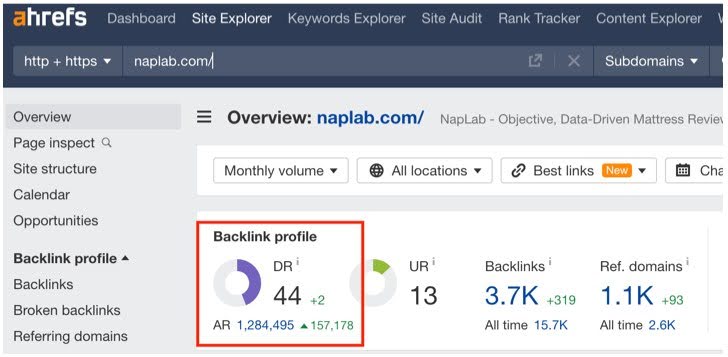
and https://startup.info/ at 77
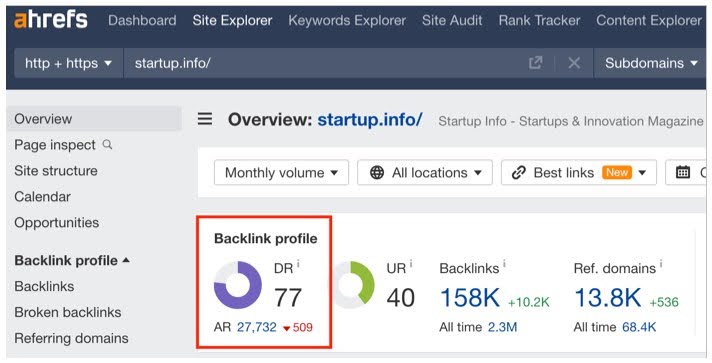
At first glance, the higher DR might seem like the better bet, right?
Not so fast.
Dig a bit deeper, and you might find the site with the lower DR buzzing with traffic (more than 130k) and engagement:
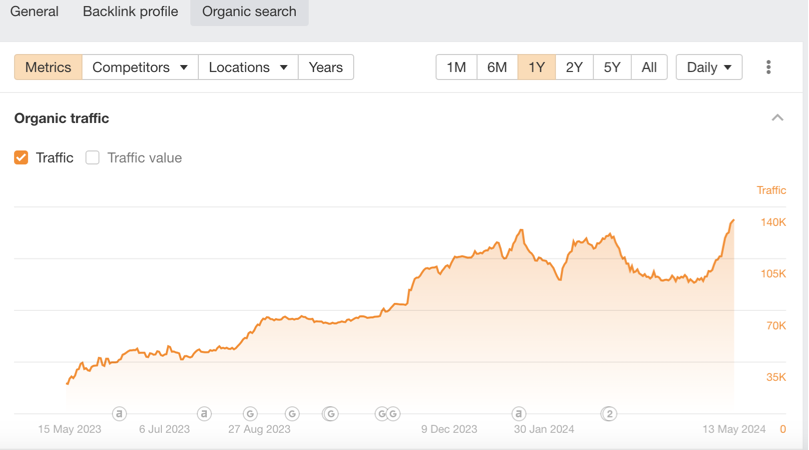
while the other one is just a link farm hit by Google penalties.
Why does this matter?
Because Google doesn’t just look at DR or DA to rank sites. Even though many in this industry, including sponsored ads, hail these metrics as the ultimate standards, they only tell part of the story.
For example, here’s what happens if you type “link building agency” in the search bar:

The thing is, both DA and DR are calculated by bots that crawl the web and analyze search results—much like Google's own algorithms.
But these bots aren’t perfect.
They collect tons of data to predict how well a site might rank, but they can miss the nuances that show a site's true value.
This is why DA and DR should be used carefully.
They’re useful, sure, but not the be-all and end-all. Consider them as part of a broader strategy that considers multiple factors to truly boost your SEO game.
And when it comes to mastering the backlink game, Editorial.Link has got you covered! We don’t just rely on DR or DA; we secure links from top-tier sites that truly add value, regardless of metrics. So, if you need help, just get in touch!
Moz's Domain Authority (DA) is a metric designed to predict how well your website will rank on search engine results pages (SERPs).
Developed by Moz in 2004, DA helps SEO professionals gauge a site's potential performance against its competitors. Thus, it quickly became a go-to metric for SEO professionals.
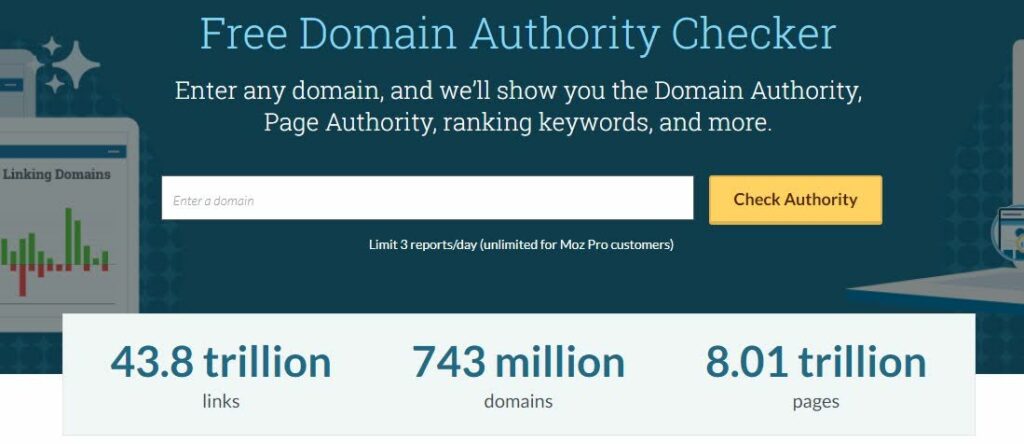
As you can see from the screenshot, the latest version pulls data from a vast index, with over 43.8 trillion links across nearly 743 million domains.
In other words, DA is a score Moz developed to compare websites on a scale from 1 to 100. The higher your DA, the more likely your site is to rank high in search results.
Note: DA is different from Page Authority, which looks at individual pages instead of the whole site.
DA is based on a comprehensive mix of factors, like the number of quality inbound links and the age of the domain. These elements are crunched by Moz’s machine learning algorithm, making DA a robust indicator of potential search engine success.
DA isn't perfect. It's a predictive tool, not a definitive measure of ranking. That means while a high DA points to potential success, it's not a guarantee. Just like Ahrefs’ DR, it’s best used as a comparative tool, not the only metric you rely on.
For a practical take, say you're sizing up your site against a competitor's. A quick check on Moz's Domain Authority Checker can show you how you stack up 😉
For example, here’s what hubspot.com (a respected platform that makes it easier for companies to attract customers, close sales, and offer great support) looks like to Moz:
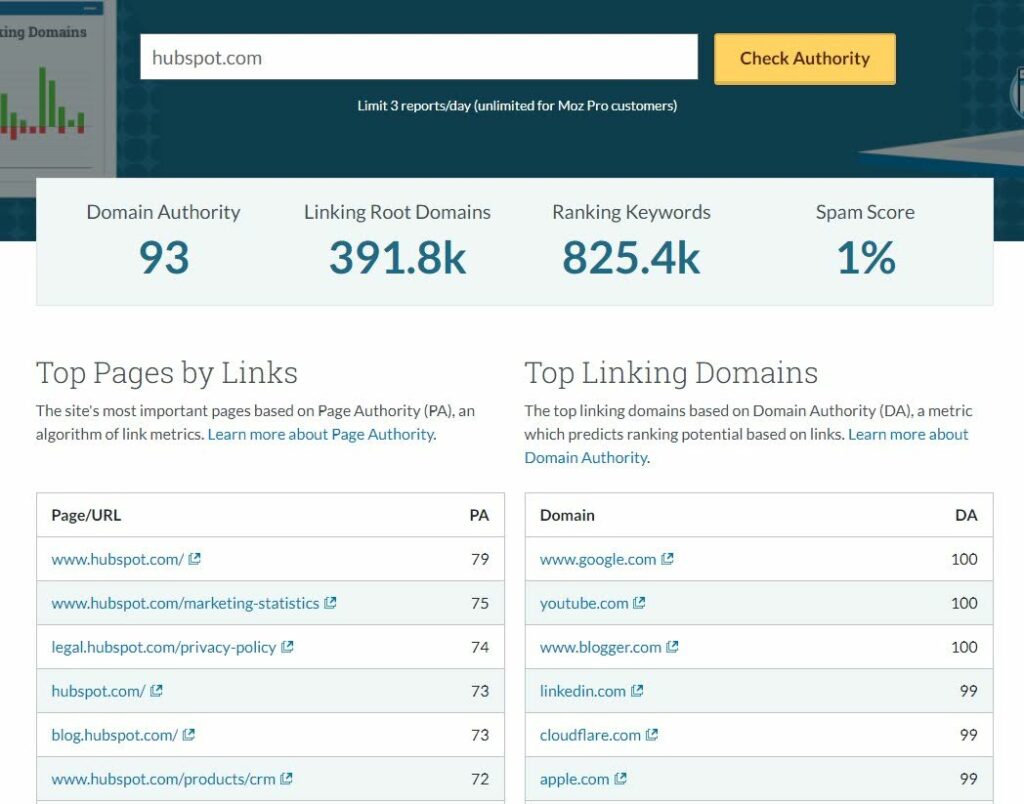
If your DA is higher, you're likely in a good spot! But if it’s lower, it’s a signal that you might need to beef up your site with better content or stronger links. It is what it is.
The cool part?
Moz keeps refining DA. Since 2019, their Domain Authority 2.0 has been tapping into an even broader data set, making the score more reliable than ever.
The DA score is calculated using about 40 key SEO factors, including linking root domains, social media signals, and the site's spam score. Plus, they update DA every few weeks or so, so it's always tuned to the latest web dynamics.
All in all, DA is a powerhouse in your SEO toolkit, and you should use it to see where you stand and refine your strategies. You can mix it with other metrics and insights to fully understand your site’s authority and potential. That’s how it works!
Developed by Ahrefs in 2016, DR is a metric that measures the strength of a website’s backlink profile on a scale from 0 to 100. It's become crucial for SEO experts to gauge a site's influence and potential in search rankings.
Here’s an example of great DR results for monday.com (the company helps teams organize their work and projects):

So what makes DR special?
It zeroes in on the number and quality of external backlinks a website garners. High-quality links boost your DR, signaling a robust backlink profile.
Just like DA, DR is updated regularly to reflect the dynamic nature of the web. As websites gain or lose backlinks, their DR can change, providing SEO experts with up-to-date insights into link profile strength.
Here’s why DR matters:
A high DR means your site has influential backlinks that could help elevate your presence in search results.
Yet, remember, DR is just one part of your SEO toolkit. While it points to potential, it doesn’t guarantee top rankings. Other factors like content quality and technical SEO play huge roles too.
Ahrefs has this covered with their cutting-edge crawler, second only to Google. Their crawler scans billions of web pages daily, maintaining a massive backlink database that's updated every 15 minutes.
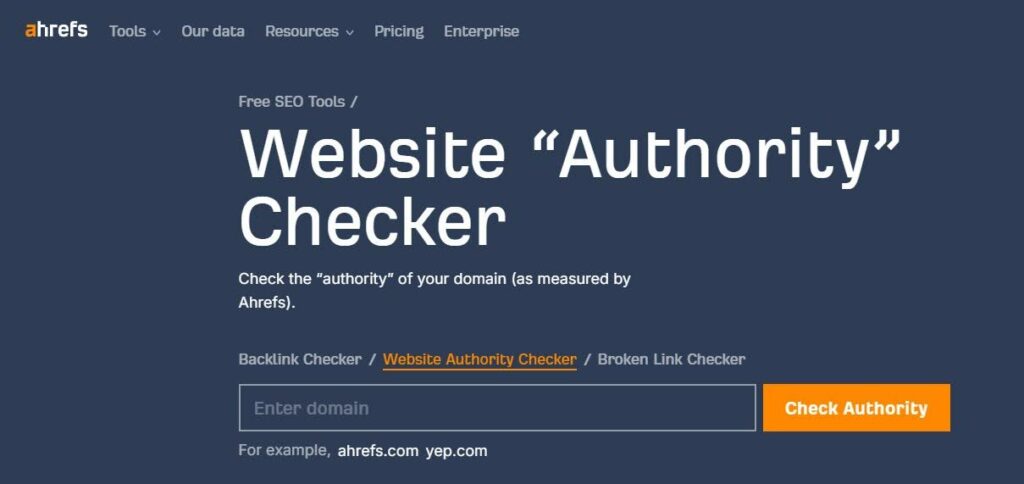
When you pop your site into Ahrefs' Website Authority Checker, it dives deep into this data, assessing both do-follow and no-follow links pointing to your site.
DR is calculated by assessing the number of unique domains linking to your site, the total backlinks, and the DR scores of these referring domains.
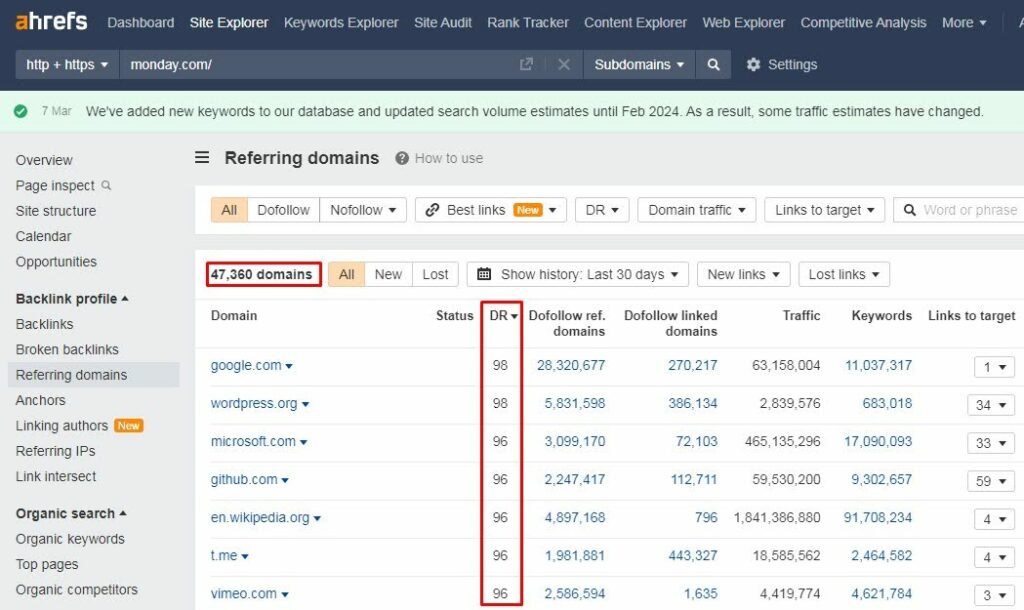
It's not just about quantity, though.
This is where quality takes the front seat, meaning a few high-caliber links can be more impactful than scores of lesser ones.
Using DR can be a game-changer for spotting link-building opportunities and sizing up the competition. It helps gauge the strength of your backlink profile compared to others in your niche, paving the way for strategic SEO maneuvers.
Remember, the aim is to enhance the overall health and authority of your site in ways that search engines reward.
So while you track your DR, keep an eye on creating valuable content and fostering genuine, high-quality backlinks that benefit your visitors. This balanced approach will help you navigate the complexities of SEO with confidence.
When assessing the strength of your website's SEO, interpreting what DA and DR scores actually mean can be a bit… nuanced. So let's dive into what constitutes a "good" DA or DR rating and why these figures are important.
A DR score, as calculated by Ahrefs, serves as a reflection of the quality and strength of a website's backlink profile.
Here's a general guideline on DR scores:
Getting back to monday.com, here’s an example of a great DR score:
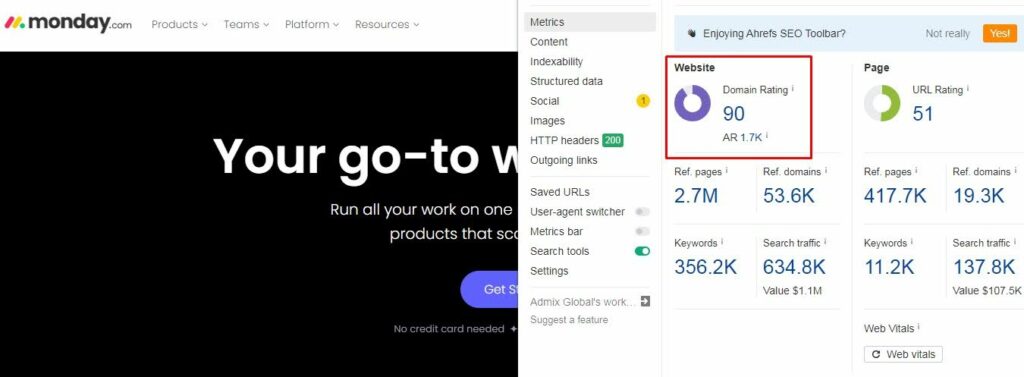
Factors such as content relevance, technical SEO, and keyword competitiveness also significantly influence overall SEO performance.
Here’s a simple breakdown of how to view DR scores in context:
| DR Score Range | Quality Indicator |
| Below 30 | Needs Improvement |
| 30 - 50 | Average to Good |
| 50 - 70 | Strong |
| 70 and above | Excellent to Elite |
Note: The same table can actually be used for DA scores.
Curious about what makes a good Domain Authority (DA) score? Let's dive right in!
Think of DA as your digital clout meter — it’s not just a number. It’s a way to gauge how you stack up against your rivals.
Are you outshining them as monday.com does or even better?
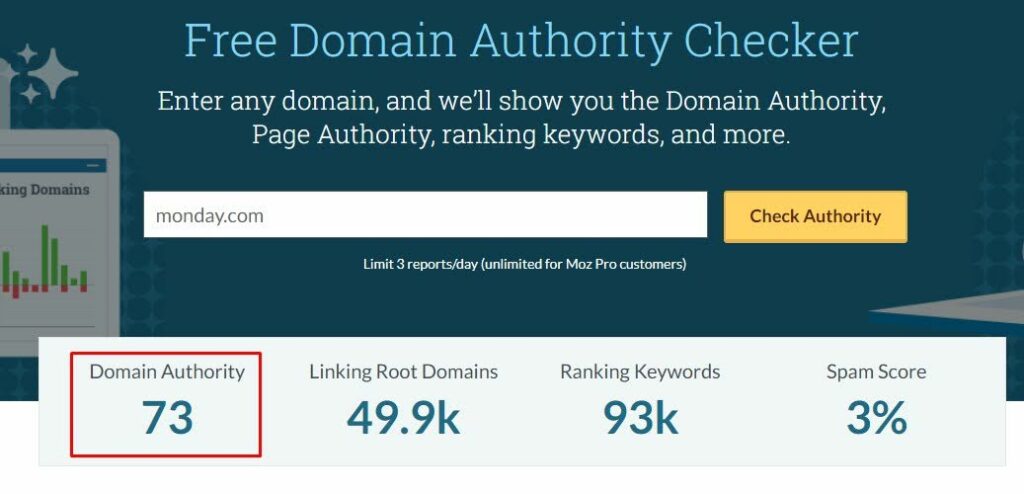
Like DR, DA is most useful when used to compare sites within the same market or sector. It's not just about having a high DA; it's about how your DA measures up to similar sites.
Aiming for a high DA or DR is good, but the ultimate goal is improving your overall SEO health.
This means:
When you line up your DA or DR next to your competitors', it sheds light on potential areas for improvement and helps pinpoint where you can edge out the competition.
Want to climb the ranks in DA and DR? Here’s how you can elevate your scores and strengthen your website's authority effectively.
A few great ways to elevate your DA:
To improve your DR, consider these tactics:
| Strategy | DA Impact | DR Impact |
| Build Quality Backlinks | High - Boosts link profile authority | High - Directly increases backlink quality |
| Improve On-Page SEO | Moderate - Enhances site usability | Moderate - Improves site attractiveness for linking |
| Remove Toxic Links | High - Cleans link profile | High - Purifies backlink quality |
| Boost Social Media Engagement | Moderate - Increases content visibility | Low - Indirect impact through increased exposure |
| Enhance Internal Linking | Moderate - Spreads link equity | Low - Minor direct impact on DR |
| Create Valuable Content | Moderate - Attracts natural backlinks | High - Directly invites quality backlinks |
| Engage in Guest Blogging | High - Secures authoritative links | High - Gains high-value links |
| Pursue Broken Link Building | Moderate - Opportunity for new backlinks | Moderate - Replaces lost link opportunities |
| Optimize On-Page Elements | Low - Improves user experience | Moderate - Makes site more link-worthy |
With all the buzz around DA and DR scores, do they actually influence your SEO rankings directly?
The short answer is no.
Both DA and DR help measure potential, but, as you already know, Google doesn’t use these metrics to rank your site.
Here's something you might find surprising: a site with a sky-high DA or DR can have almost zero traffic and low-quality content.
Why?
Because these scores don’t guarantee that real users find the content valuable—they only reflect the site's backlink strength.
Ever had trouble getting backlinks because your DA or DR seemed too low, even though your site is active and runs a legitimate business?
I have…
And the worst thing is that this common issue can make it harder for you to get valuable collabs and endorsements from top-rated sites.
For example, here’s what you can get in response when reaching out to websites and trying to build links for a low-DR site:

Another one

Note: Some websites with a 60 DR still aren't seeing significant business results. This could be because they're supported by many low-quality links that don't effectively impact their real-world performance.
When comparing DA vs DR in SEO, it's important to recognize that each metric highlights distinct elements of your site's authority and link profile.
Both DR and DA aim to size up a site's authority, but they do so using different lenses.
Here's a clearer look at how these metrics stack up:
| Aspect | Domain Rating (DR) | Domain Authority (DA) |
| Developed by | Ahrefs | Moz |
| Focus | Backlink profile strength | Overall site authority based on link profile |
| Calculation Factors | Quality and number of backlinks, diversity of backlinks | Number and quality of links, domain age, site size |
| Typical Use | Evaluating backlink strength | Predicting ranking potential |
What sets them apart?
Understanding the differences between DR vs DA can significantly enhance your SEO efforts by guiding you to focus on the most effective strategies for boosting your site's visibility.
Understanding DA and DR is critical for refining your SEO tactics, but remember—they're just part of the broader SEO puzzle.
These metrics offer insights into possible search engine performance based on backlink profiles but aren’t foolproof predictors of ranking success.
Use DA and DR to:
Ultimately, DA and DR should inform your strategy, not dictate it.
By integrating these insights with comprehensive SEO practices, you’ll not only boost your website’s authority but also its overall search engine performance and user engagement.